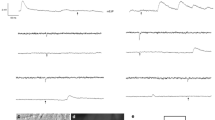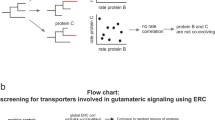Abstract
Studies of synaptic homeostasis during muscle fiber (MF) growth in Drosophila larvae have focused on the regulation of the quantal content of transmitter release. However, early studies in crayfish and frog suggested that regulation of quantal current size may be an integral mechanism in synaptic homeostasis. To examine this further in Drosophila, we compared the electrical properties, miniature excitatory postsynaptic potentials (minEPSPs) and miniature excitatory postsynaptic currents (minEPSCs) in different-sized MFs in third-instar larvae and for a single MF during larval growth. The third-instar MFs showed differences in input resistance due to differences in size and specific membrane resistance. We found that electrical coupling between MFs did not contribute substantially to the electrical properties; however, the electrode leak conductance and a slower developing increase in membrane conductance can influence the electrical recordings from these MFs. Our results demonstrated that larger MFs had larger minEPSCs to compensate for changes in MF electrical properties. This was most clearly seen for MF4 during larval growth from the second to third instar. During a predicted 80 % decrease in MF input resistance, the minEPSCs showed a 35 % increase in amplitude and 165 % increase in duration. Simulations demonstrated that the increase in minEPSC size resulted in a 129 % increase in minEPSP amplitude for third-instar larvae; this was mainly due to the increase in minEPSC duration. We also found that MFs with common innervation had similar-sized minEPSCs suggesting that MF innervation influences minEPSC size. Overall, the results showed that increased quantal content and quantal current size contribute equally to synaptic homeostasis during MF growth.






Similar content being viewed by others
References
Bennett MV (1966) Physiology of electrotonic junctions. Ann N Y Acad Sci 137:509–539
Bodenstein D (1950) The postembryonic development of Drosophila. In: Demerec M (ed) Biology of Drosophila, first edn. John Wiley & Sons, Inc., New York, pp. 275–367
Daniels RW, Collins CA, Chen K, Gelfand MV, Featherstone DE, DiAntonio A (2006) A single vesicular glutamate transporter is sufficient to fill a synaptic vesicle. Neuron 49:11–16
Davis GW, DiAntonio A, Petersen SA, Goodman CS (1998) Postsynaptic PKA controls quantal size and reveals a retrograde signal that regulates presynaptic transmitter release in drosophila. Neuron 20:305–315
Davis GW, Goodman CS (1998) Synapse-specific control of synaptic efficacy at the terminals of a single neuron. Nature 392:82–86
Davis GW, Muller M (2015) Homeostatic control of presynaptic neurotransmitter release. Annu Rev Physiol 77:251–270
DeRosa RA, Govind CK (1978) Transmitter output increases in an identifiable lobster motoneurone with growth of its muscle fibres. Nature 273:676–678
DiAntonio A (2006) Glutamate receptors at the Drosophila neuromuscular junction. Int Rev Neurobiol 75:165–179
DiAntonio A, Petersen SA, Heckmann M, Goodman CS (1999) Glutamate receptor expression regulates quantal size and quantal content at the Drosophila neuromuscular junction. J Neurosci 19:3023–3032
Dulhunty AF, Franzini-Armstrong C (1975) The relative contributions of the folds and caveolae to the surface membrane of frog skeletal muscle fibres at different sarcomere lengths. J Physiol 250:513–539
Featherstone DE, Rushton E, Broadie K (2002) Developmental regulation of glutamate receptor field size by nonvesicular glutamate release. Nat Neurosci 5:141–146
Feng Y, Ueda A, Wu CF (2004) A modified minimal hemolymph-like solution, HL3.1, for physiological recordings at the neuromuscular junctions of normal and mutant Drosophila larvae. J Neurogenet 18:377–402
Gertner DM, Desai S, Lnenicka GA (2014) Synaptic excitation is regulated by the postsynaptic dSK channel at the Drosophila larval NMJ. J Neurophysiol 111:2533–2543
Harris JB, Ribchester RR (1979) The relationship between end-plate size and transmitter release in normal and dystrophic muscles of the mouse. J Physiol 296:245–265
Heckmann M, Dudel J (1998) Evoked quantal currents at neuromuscular junctions of wild type Drosophila larvae. Neurosci Lett 256:77–80
Hoang B, Chiba A (2001) Single-cell analysis of Drosophila larval neuromuscular synapses. Dev Biol 229:55–70
Hodgkin AL, Nakajima S (1972) The effect of diameter on the electrical constants of frog skeletal muscle fibres. J Physiol 221:105–120
Jan LY, Jan YN (1976) Properties of the larval neuromuscular junction in Drosophila melanogaster. J Physiol 262:189–214
Johnston D, Wu SM (1995) Foundations of cellular neurophysiology. The MIT Press, Cambridge MA
Karunanithi S, Marin L, Wong K, Atwood HL (2002) Quantal size and variation determined by vesicle size in normal and mutant Drosophila glutamatergic synapses. J Neurosci 22:10267–10276
Kuno M, Turkanis SA, Weakly JN (1971) Correlation between nerve terminal size and transmitter release at the neuromuscular junction of the frog. J Physiol 213:545–556
Ljaschenko D, Ehmann N, Kittel RJ (2013) Hebbian plasticity guides maturation of glutamate receptor fields in vivo. Cell Rep 3:1407–1413
Lnenicka GA, Keshishian H (2000) Identified motor terminals in Drosophila larvae show distinct differences in morphology and physiology. J Neurobiol 43:186–197
Lnenicka GA, Mellon D Jr (1983) Changes in electrical properties and quantal current during growth of identified muscle fibres in the crayfish. J Physiol 345:261–284
Lnenicka GA, Mellon D Jr (1983) Transmitter release during normal and altered growth of identified muscle fibres in the crayfish. J Physiol 345:285–296
Marrus SB, DiAntonio A (2004) Preferential localization of glutamate receptors opposite sites of high presynaptic release. Curr Biol 14:924–931
Paradis S, Sweeney ST, Davis GW (2001) Homeostatic control of presynaptic release is triggered by postsynaptic membrane depolarization. Neuron 30:737–749
Pawlu C, DiAntonio A, Heckmann M (2004) Postfusional control of quantal current shape. Neuron 42:607–618
Petersen SA, Fetter RD, Noordermeer JN, Goodman CS, DiAntonio A (1997) Genetic analysis of glutamate receptors in Drosophila reveals a retrograde signal regulating presynaptic transmitter release. Neuron 19:1237–1248
Sandstrom DJ (2004) Isoflurane depresses glutamate release by reducing neuronal excitability at the Drosophila neuromuscular junction. J Physiol 558:489–502
Schaff J, Fink CC, Slepchenko B, Carson JH, Loew LM (1997) A general computational framework for modeling cellular structure and function. Biophys J 73:1135–1146
Schmid A, Hallermann S, Kittel RJ, Khorramshahi O, Frolich AM, Quentin C, Rasse TM, Mertel S, Heckmann M, Sigrist SJ (2008) Activity-dependent site-specific changes of glutamate receptor composition in vivo. Nat Neurosci 11:659–666
Sigrist SJ, Thiel PR, Reiff DF, Lachance PE, Lasko P, Schuster CM (2000) Postsynaptic translation affects the efficacy and morphology of neuromuscular junctions. Nature 405:1062–1065
Slepchenko BM, Schaff JC, Macara I, Loew LM (2003) Quantitative cell biology with the virtual cell. Trends Cell Biol 13:570–576
Staley KJ, Otis TS, Mody I (1992) Membrane properties of dentate gyrus granule cells: comparison of sharp microelectrode and whole-cell recordings. J Neurophysiol 67:1346–1358
Stefani E, Steinbach AB (1969) Resting potential and electrical properties of frog slow muscle fibres. Effect of different external solutions J Physiol 203:383–401
Steinert JR, Kuromi H, Hellwig A, Knirr M, Wyatt AW, Kidokoro Y, Schuster CM (2006) Experience-dependent formation and recruitment of large vesicles from reserve pool. Neuron 50:723–733
Stewart BA, Atwood HL, Renger JJ, Wang J, Wu CF (1994) Improved stability of Drosophila larval neuromuscular preparations in haemolymph-like physiological solutions. J Comp Physiol A 175:179–191
Wilkinson RS, Lunin SD, Stevermer JJ (1992) Regulation of single quantal efficacy at the snake neuromuscular junction. J Physiol 448:413–436
Acknowledgments
Research supported by National Science Foundation Grant IOS1051605 (G. A. Lnenicka). The Virtual Cell is supported by National Institute of General Medical Sciences Grant P41 GM-103313 from the National Center for Research Resources.
Author information
Authors and Affiliations
Corresponding author
Rights and permissions
About this article
Cite this article
Powers, A.S., Grizzaffi, J., Ribchester, R. et al. Regulation of quantal currents determines synaptic strength at neuromuscular synapses in larval Drosophila . Pflugers Arch - Eur J Physiol 468, 2031–2040 (2016). https://doi.org/10.1007/s00424-016-1893-7
Received:
Revised:
Accepted:
Published:
Issue Date:
DOI: https://doi.org/10.1007/s00424-016-1893-7




